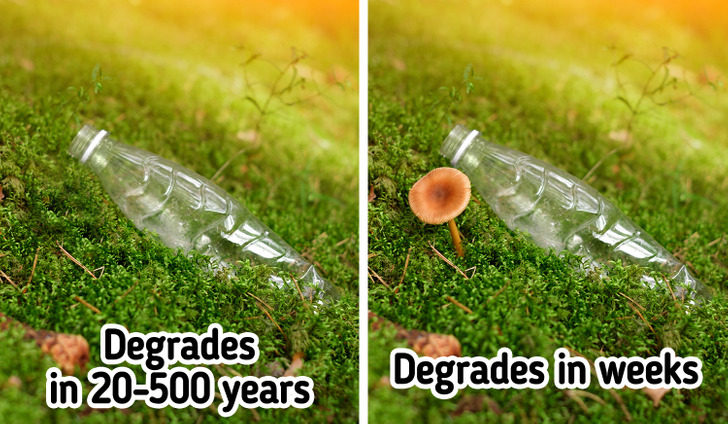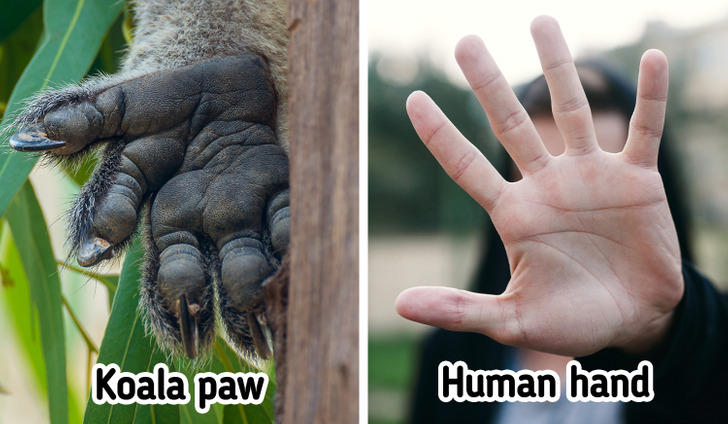The world is a big, wonderful place full of facts we never thought possible. For instance, if a pregnant mouse has a sudden medical issue, the fetus will send stem cells to heal the mother, increasing its chances of survival as well. Fetal stem cells have been found in human mothers as well, dubbed by science as microchimerism.
Bright Side dug up some more marvelous facts about nature and its creations, upholding our yearly resolutions to spread knowledge and joy.
1. The heart slows when your face touches water.

As mammals, we can’t breathe underwater, so as part of the mammalian dive reflex, our heart rate goes down in the water — more so if we go underwater. Even splashing the face with water makes the heart slow down, making it a great way to calm down.
2. Fungus can break down plastic in weeks.

It is said that in the future, there may be more plastic in the ocean than fish. This is why the plastic-eating fungus is great news, and there are around 50 new species of such fungi discovered already. One of the fungi discovered can digest plastic within 2 months, so there’s hope for us yet.
3. Newborn babies can support their own weight.

Newborn babies are strong — strong enough to be able to grasp things in their tiny fists and even support their weight as shown by an experiment done in the nineteenth century. Louis Robinson witnessed babies able to hang from a walking stick, from 10 seconds to 2 minutes and 35 seconds.
4. Koala fingerprints have been mistaken for human ones.

We’ve been told that our fingerprints are unique, and they are. But the fact remains that even though we share a common ancestor with the koala that was alive 100 million years ago, koala fingerprints look very similar to human fingerprints, as do chimpanzee fingerprints for that matter.
5. Snails can sleep for 3 years.

If you thought bears had it good with hibernation, meet the snail. Snails can sleep rather than hibernate for 3 years at a time without needing food. Of course, this is with some snail species, not all of them. Meanwhile, bears usually hibernate for just 4-8 months.
6. Sloths need 2 weeks to digest food.

Sloths don’t only move in slow motion — even their insides move slowly, ostensibly to preserve energy, which is why a sloth’s digestive system takes 2 weeks to process the food it ate. Plus, most of what it eats is indigestible, giving it very little energy from each slowly chewed mouthful.
On the other end of the spectrum lies the shrew, whose digestion takes mere minutes and is done so fast, not much of it is fully digested. This is the reason why shrews eat their own feces. They can die of starvation in a matter of hours if they don’t eat.
7. Your brain ignores seeing your nose.

We can see our nose all the time, it’s just that the brain tends to ignore it because it’s a constant visual stimulus. It’s the same with people who wear glasses. After a while, they simply stop noticing them.
8. Your forearm is the same length as your foot.

If you don’t have the time to try on a shoe, measure it from your elbow crease to your wrist. If it fits or is just a little smaller, it would fit your foot because the length of your forearm is the same as your foot. And this is just one of many human body ratios that are a marvel in themselves, including the fact that your femur bone is one-quarter your height.
9. You can “see” your white blood cells.

If you look up at a cloudless, bright blue sky and see some wiggly things at the periphery of your vision, you’ve just experienced the blue field entoptic phenomenon. The wiggly things are white blood cells moving in the fine blood vessels moving in front of the retina, at the back of the eye.
10. Human beings have striped skin, but only cats can see it.

Human beings have stripes and patterns on the skin too, and they are called Lines of Blaschko, name eponymously by the scientist who discovered them, Dr. Alfred Blaschko. These are closer to tiger stripes, forming more of a V-pattern fanning out from the center to the extremities. These lines are visible under UV light, a spectrum that cats can see too, which is why cats can see you as a striped being as well.
Which of these facts turned out to be a revelation for you? Share your extreme nature facts with us and blow us away.
Preview photo credit Shutterstock.com, Shutterstock.com
Working as a Waitress at a Wedding, I Froze When I Saw My Own Husband Dressed as the Groom — Story of the Day

While serving at a wedding, I suddenly spotted the groom—it was my husband, David. Seeing him with another woman, pretending to be someone else, sent my world crashing down. In that moment, everything I thought I knew about my life was turned upside down.
Oh, weddings… They always had a way of stirring up old memories, bringing me back to that day when David and I said our vows. Our wedding wasn’t anything grand or over the top—far from it, actually.

For illustration purposes only. | Source: Pexels
We were just two young people in love, not concerned about fancy decorations or a big reception. Even now, after seven years of marriage, those memories still brought a smile to my face.
Working as a waitress for a catering company meant that I was always around weddings. Every time I walked into a beautifully decorated hall, the smell of fresh flowers in the air, I couldn’t help but think back to our simple ceremony. If only I had known how fragile things could be…
That day, just like any other, we arrived early to set everything up before the guests and the newlyweds showed up.

For illustration purposes only. | Source: Midjourney
About an hour later, the guests started arriving, their excited chatter filling the hall as they waited for the bride and groom to return from their photo session. I was in the restroom when Stacy, my colleague, burst in, her face pale with worry.
“Lori, listen,” Stacy said, her voice shaky, “I think you should go home.”
“Go home? Why would I do that?” I asked. “Are you trying to get more shifts for yourself? Sorry, but I need the money just as much as you do.”
Stacy shook her head, looking more nervous than I’d ever seen her. “No, Lori, you don’t understand. I really think you shouldn’t be here.”

For illustration purposes only. | Source: Midjourney
“What are you talking about? Why are you acting so weird?” I said. “Stacy, seriously, what’s going on?”
She bit her lip, glancing toward the hall. “You’re not going to like what you see.”
I headed back to the hall, my mind racing with thoughts of what Stacy had said. My heart nearly stopped when I saw the bride and groom. Stacy was right—I shouldn’t have come.
There, standing in front of all the guests, was David… my David. The man I had shared my life with for seven years, now standing with another woman.

For illustration purposes only. | Source: Pexels
My breath caught in my throat. I felt like the ground had been ripped out from under me. I couldn’t make sense of what I was seeing. I turned and ran outside, tears streaming down my face. It was like a nightmare, one I couldn’t wake up from.
Outside, I collapsed against the wall, gasping for air. My vision blurred with tears, but I forced myself to look at the sign with the bride and groom’s names: “Welcome to the wedding of Kira and Richard.” Richard? What a liar!
Stacy rushed outside. She tried to speak, to comfort me, but I couldn’t hear her. All I could think about was how he had betrayed me. I wiped my tears away, anger building inside me. I wasn’t going to let him get away with this. No way. I was going to ruin this wedding and expose him for the fraud he was.

For illustration purposes only. | Source: Midjourney
I returned to the hall just as the bride and groom were giving their first toast. My heart pounded in my chest, but I knew I had to do this.
I marched straight up to David and snatched the microphone right out of his hand. He looked at me, his face full of shock and anger, but I didn’t care. He deserved every bit of what was coming.
“I have an announcement!” I shouted into the microphone, my voice echoing through the hall. Every head turned toward me, the room falling into a stunned silence.
The bride, this poor woman, clung to David like he was her lifeline. She looked at me with wide, fearful eyes, clearly not understanding what was happening.

For illustration purposes only. | Source: Midjourney
“David, or as you all know him, Richard, has deceived you all!” I began, my voice trembling with rage. “He’s already married! To me!” The words hung in the air like a bomb that had just gone off. Gasps rippled through the crowd, and I could see the confusion and disbelief on their faces.
“What?” the bride stammered, her voice barely above a whisper. She turned to David, her eyes filling with tears. “Richard, what’s going on? Who is this woman?”
David shook his head, his face a mask of feigned confusion. “I… I don’t know,” he stammered. “I’ve never seen this woman in my life.”
“Seven years of marriage, and you were blind?!” I shouted, feeling my anger boil over.

For illustration purposes only. | Source: Midjourney
“What? What seven years of marriage?” he asked, still trying to play dumb.
“Stop pretending you don’t know me,” I said. “You’re only making it worse, David.”
“My name is Richard!” he shouted back, his voice desperate. “I have no idea who your David is. You’re crazy!”
“Oh, really?” I said, narrowing my eyes. “Then what’s this?” I pulled out my phone, the screen lit up with a picture of our wedding day. I held it up for everyone to see. The room fell into a deeper silence as people strained to get a look.

For illustration purposes only. | Source: Midjourney
The bride, Kira, stepped closer, her eyes locking onto the image. “Richard…?” she asked, her voice trembling. “How could you do this to me? How could you lie to me like this? And to her?” She pointed at me, her hand shaking as tears spilled down her cheeks.
“Kira,” Richard said, his voice softening as he reached for her. “I swear, I don’t know who this woman is or why she has a photo with me. I would never hurt you.”
But the bride shook her head, backing away from him. “I loved you, Richard… or David, or whoever you really are,” she said, her voice breaking. “How could you betray me like this? I don’t even know who you are anymore.”

For illustration purposes only. | Source: Midjourney
“I’m Richard,” he insisted, desperation creeping into his voice. “And I love you, Kira. I’m telling the truth!”
I couldn’t hold back a bitter laugh. “He’s probably only with you for your money,” I said, the words dripping with contempt.
“Shut up!” David yelled, his voice raw with anger and fear.
The bride shook her head, tears streaming down her face. “No, Richard, I can’t do this. I can’t be with someone who could lie like this, who could do something so awful.”

For illustration purposes only. | Source: Midjourney
She turned to me. “I’m sorry,” she whispered. “I really didn’t know.”
“It’s not your fault,” I replied, my voice softening. “He deceived us both.”
“Kira, please,” David begged, but it was too late. She was already turning, running toward the door, her wedding dress trailing behind her like a broken dream.
Without a second thought, David bolted after her. “Kira! Wait!” he shouted as he disappeared through the doors after her, leaving the stunned guests and me standing there in silence.

For illustration purposes only. | Source: Midjourney
I stormed outside, ready to tell David I was done and filing for divorce. But when I found him, he was sitting on the curb, tears streaming down his face.
“Of course, play the drama,” I said, crossing my arms.
He looked up, his face twisted with anger. “You! This is all your fault!” he shouted. “My wife ran away from me, and it’s because of you! Some crazy waitress!”
“I’m the crazy one?!” I yelled back. “You’re the one who married another woman while still being married to me!”

For illustration purposes only. | Source: Midjourney
“I’m not your husband! I’ve never seen you before in my life!”
“Oh, really?” I challenged, pulling out my phone. “Then let’s call David, who you claim you’re not, and see what happens.”
“Go ahead, call him!” he snapped.
I dialed David’s number, putting it on speaker, but the phone just kept ringing. “How strange that you’re not picking up,” I said, my voice dripping with sarcasm.

For illustration purposes only. | Source: Midjourney
Then, suddenly, the ringing stopped, and I heard his voice. “Yes, dear. Is everything okay?”
“What the…?” I stammered, staring at the man in front of me.
“I told you I’m not your husband!” he said, his voice calmer now, but still tense.
“Honey,” I said into the phone, trying to keep my voice steady, “I think you should come here; something strange is going on.”

For illustration purposes only. | Source: Midjourney
David arrived about half an hour later. For what felt like forever, he and Richard just stood there, staring at each other in complete silence. It was like looking into a mirror—they were identical in every way.
Finally, Richard broke the silence, turning to me with a wry smile. “Well, if I were in your shoes, I would’ve done the same,” he said.
David’s eyes shifted to me, filled with hurt and confusion. “How could you think I would do something like this to you?” he asked quietly.

For illustration purposes only. | Source: Midjourney
“He’s your exact double,” I blurted out, desperate to make him understand.
“Yes,” David replied, his voice soft. “But it still hurts that you thought that.”
“I’m sorry, honey. I was just so angry and hurt,” I said, reaching for his hand.
As it turned out, Richard and David were both adopted from the same orphanage when they were just babies. But they were taken in by different families. They had no idea the other existed. I couldn’t believe what I was hearing. My husband had a twin brother he never knew about.

For illustration purposes only. | Source: Midjourney
“But that doesn’t change the fact that my wife hates me,” Richard said, his voice filled with despair.
“We’ll fix that,” I replied.
“Yes, get in my car, and let’s go,” David added, already moving toward the car.
“She’ll never forgive me,” Richard muttered.

For illustration purposes only. | Source: Midjourney
“She will when she sees David,” I assured him.
We drove in silence to the hotel where Kira was likely staying. We went to her room, but she wouldn’t let us in. I could hear her crying through the door, and it broke my heart.
We didn’t give up. We stood outside under her window, shouting up at her, trying to get her attention. Finally, she looked out the window, her eyes red from crying.
“Kira!” I shouted, waving my arms to get her attention. “Your fiancé didn’t lie to you! And my husband didn’t cheat on me! Look!” I pointed to Richard and David, who stood side by side, identical in every way.

For illustration purposes only. | Source: Midjourney
Kira’s eyes widened in shock. “How is this possible?!” she shouted down at us.
“We were separated in the orphanage!” Richard shouted back.
For a moment, she just stared at us, then she closed the window, and our hearts sank.
“See? I told you she wouldn’t forgive me,” Richard said, his voice heavy with defeat. But just as the words left his mouth, the door burst open, and Kira ran out, tears streaming down her face. She threw her arms around Richard and kissed him, holding him tight.

For illustration purposes only. | Source: Midjourney
David pulled me into a hug. “I’m sorry I doubted you,” I said softly, looking up at him.
David smiled, brushing a strand of hair from my face. “Oh, I think I would’ve done the same. Honestly, I’m flattered that after seven years of marriage, you’re still willing to fight for me.”
I laughed, nudging him playfully before leaning in to kiss him. So, my husband gained a brother, and I gained a friend I can’t imagine my life without.

For illustration purposes only. | Source: Pexels
Tell us what you think about this story and share it with your friends. It might inspire them and brighten their day.
If you enjoyed this story, read this one: My son Scott, who had never dated anyone, suddenly showed up with a sweet girl and announced they were getting married next week. I was shocked, thrilled, and confused all at once. But as the truth unraveled, I realized our family was about to face a challenge I never saw coming.
This piece is inspired by stories from the everyday lives of our readers and written by a professional writer. Any resemblance to actual names or locations is purely coincidental. All images are for illustration purposes only. Share your story with us; maybe it will change someone’s life.



Leave a Reply